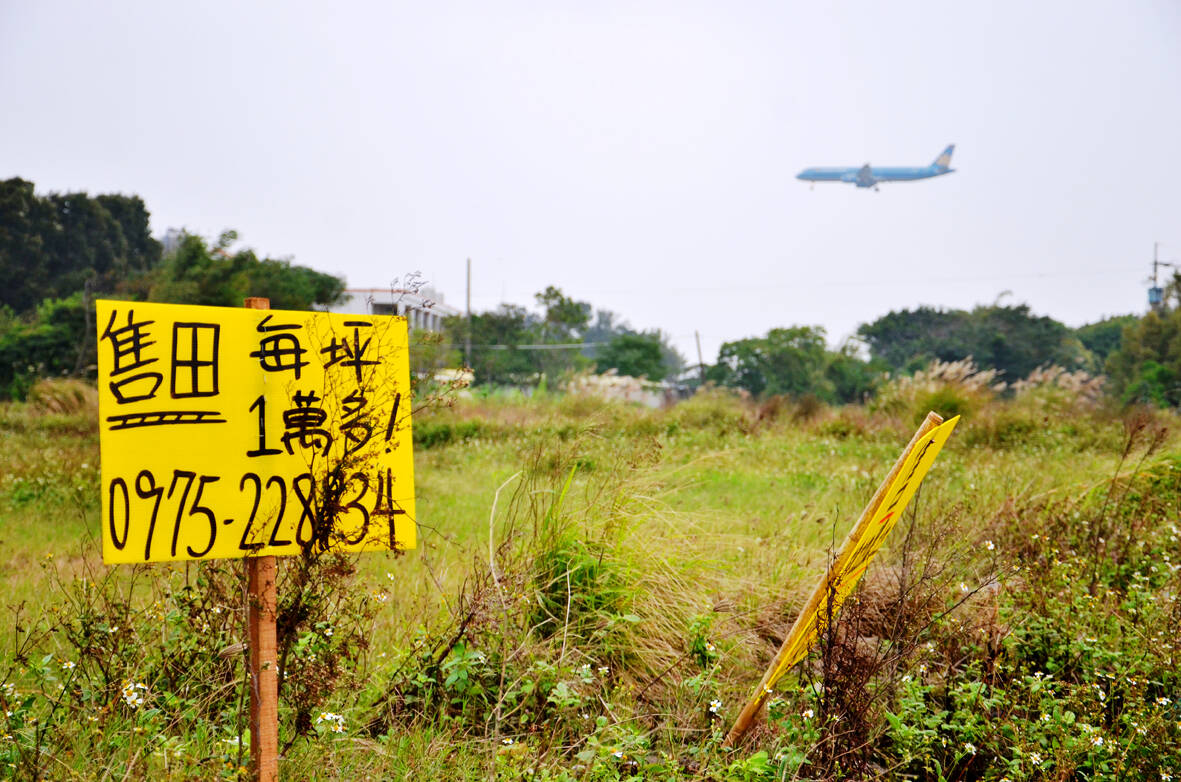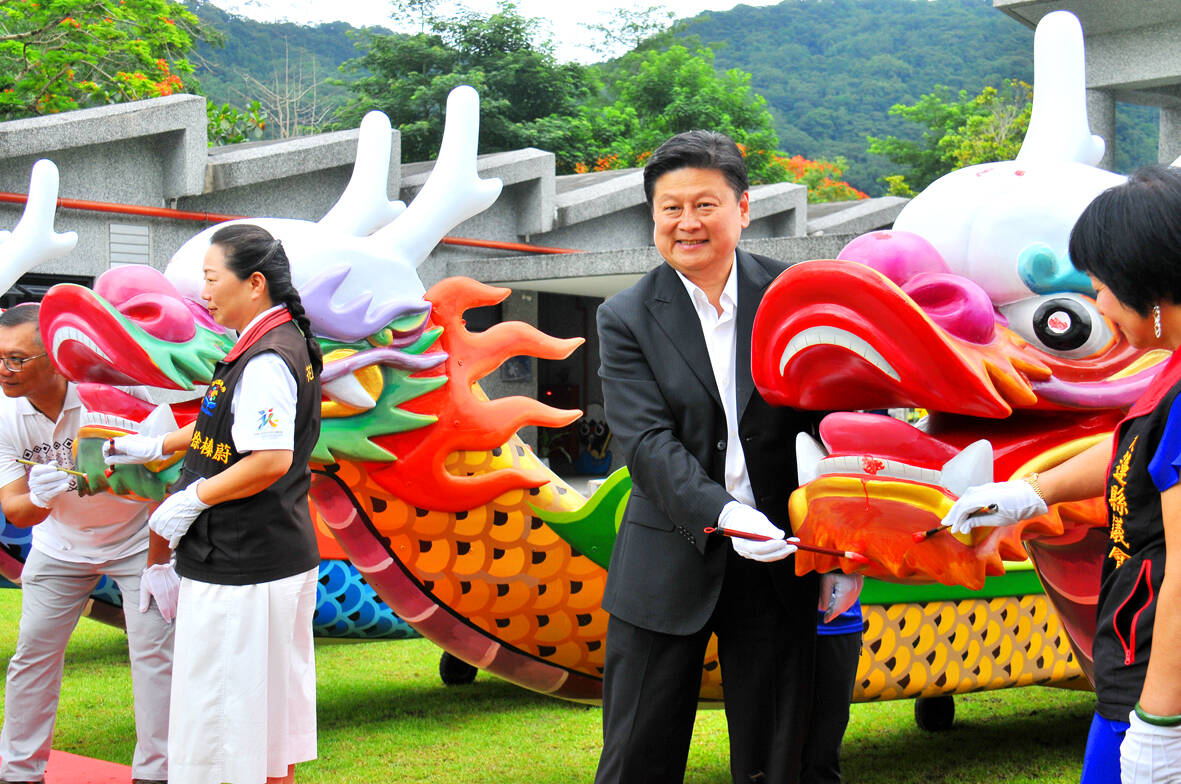During the administration of president Ma Ying-jeou (馬英九) of the Chinese Nationalist Party (KMT), the government began work on the Taoyuan Aerotropolis, a massive project to turn land around Taoyuan airport into a freeport via the largest land expropriation for a single project in Taiwan’s history. For the US$15 billion, 4,700 hectare project, around 3,200 hectares of land were to be seized, displacing over 40,000 people, along with schools and other public infrastructure. The project was a Ma administration centerpiece, announced with great fanfare in 2009 “to lead economic takeoff,” it was later said, while by 2014 then-transportation and communications minister Yeh Kuang-shih (葉匡時) warned that the nation would be “through” if it were not completed. In the Ma era the idea of competitiveness was wielded like a club, to silence opposition. Especially Taiwan-centered opposition.
As originally conceived, the Aerotropolis offered a range of entirely odious exemptions from the laws governing land and labor that sparked years of negative commentary, protests and public opposition. Its provisions thus illuminate the probable program of current KMT legislative convener Fu Kun-chi’s (傅?萁) plans for the “Three Transportation Projects” — the extension of the high speed rail (HSR) line around the island, the highway from Hualien to Taitung through the east coast Rift Valley and a highway tunnel through the mountains from Taichung to the Rift Valley.
Under the Ma administration, in late 2012 the legislature passed laws permitting firms from the People’s Republic of China (PRC) to participate in infrastructure projects in Taiwan. A major target of this was the Aerotropolis. For example, in November 2013, the chairman of the PRC’s Association of Relations Across the Taiwan Straits (ARATS), Chen Deming (陳德銘), visited Taiwan. His visit was connected to the services pact the Ma administration was attempting to shove through the legislature (it would trigger the Sunflower occupation of the legislature a few months later), but one of the places he toured was the Taoyuan Aerotropolis project.

Photo: Chiu Yi-tung, Taipei Times
DEVELOPMENTALIST MENTALITY
The Aerotropolis project summoned the worst of the nation’s developmentalist mentality. Hearings were expedited and did not meet the Executive Yuan guidelines for such projects in the number of public officials in attendance and other issues, as prominent commentator J. Michael Cole observed in a wonderful late 2013 essay. According to Cole, local organizations were told that whatever the outcome of the hearings, there was nothing they could do if the government decided to demolish their homes. The Ma government’s neglect of regulations in shoving the project forward echoed its neglect of legislative due process in pushing the services pact that sparked the Sunflowers, and of course, the recent procedural omissions in Fu’s ongoing legislative “reform.”
Along with the Aerotropolis, the Ma administration was forwarding the idea of free economic zones (FEZ). In 2014 pilot projects were slated for Keelung Port, Suao Port in Yilan County, Taipei Port (also visited by Chen Deming in November of 2013), Taichung Port, Anping Port in Greater Tainan, Kaohsiung Port, the Taoyuan Aerotropolis and the Pingtung Agricultural Biotechnology Park. The eventual plan was that they would dot the whole nation, a multitude of miniature banana republics. In the draft proposals, firms in the zones were exempted from land laws such as the Regional Plan Act (區域計畫法), the Environmental Impact Assessment Act (環境影響評估法) and the Government Procurement Act (政府採購法), while the chief administrators were given almost unlimited power over environmental protection, labor affairs, construction, commercial registration, licensing and taxation, DPP lawmaker Tsai Chi-chang (蔡其昌) said at the time.

Photo: Hua Meng-ching, Taipei Times
In addition to bringing in PRC construction firms and PRC goods, one goal of these projects was to bring laborers from the PRC into Taiwan. In the drafts of its regulations, the Aerotropolis was exempted from labor rules, and indigenous groups complained. Eventually this was revised to guarantee 3 percent of jobs to indigenous people. The FEZ draft rules also included labor exemptions that would have made it possible to bring in labor from the PRC.
These two thrusts of the Ma administration, bringing in firms and labor from the PRC, took place at the same time as two other programs. One was the use of the Special Investigative Division (SID) to prosecute Democratic Progressive Party (DPP) politicians I discussed in last week’s column. The other was the services pact, which would have opened the island’s service firms to PRC domination, including — but the reader has already guessed it — long-term residency for PRC citizens who operated businesses here. It would have opened only Fujian Province to Taiwan firms in exchange for opening the entire nation to PRC firms, implicitly subordinating Taiwan to Fujian.
Take a step back and look at Fu Kun-Chi’s program. One element of it is the three large transportation projects, which practically beg for PRC investment and labor. Another is the revival of the SID — he has specifically called for an “opposition SID” to investigate the DPP. And the other? Recall that during the presidential election both the KMT’s candidate Hou You-yi (侯友宜) and Taiwan People’s Party (TPP) candidate Ko Wen-je (柯文哲) called for reviving the services pact.
These are not separate programs, separately devised and put forth. Together they form an overall program of delivering Taiwan to China by treaties, flooding Taiwan with PRC citizens and firms via massive infrastructure projects and suppressing local opposition using the SID.
FINANCING A BOONDOGGLE
Fu’s bill for the HSR project permits four methods of financing: private participation in infrastructure projects (PPP) build-operate-transfer (BOT), auction BOT to international bidders, sovereign wealth funds and government debt. All of these could potentially permit fund inflows from the PRC. At present the PRC’s One Belt, One Road (OBOR) program is not permitted in Taiwan, but numerous workarounds are available. One way is to simply recycle money through shell firms in offshore tax havens. In the Ma era in some years over a third of foreign direct investment came from such areas, most likely recycled Taiwanese investment money (many firms offshore not for nefarious reasons, but because of Taiwan’s onerous corporate laws, which demand, for example, that the firm boards meet in person instead of virtually).
The bill exempts the projects from government debt limits. Fu was backpedaling last week, promising that special budgets to pay for the program will not be necessary. After all, the projects will crowd out money other KMT mayors want for their constituencies. However, he has not promised to exclude sovereign wealth funds from funding them, a clear invitation for the PRC to find ways to slip cash into the enormous program.
Because of the growing labor shortages in Taiwan, firms will find it difficult to source workers, especially on the east coast. They will make the idea of importing labor irresistible, and sooner or later the issue of PRC workers will be raised.
KMT IRRELEVENCE
It’s not difficult to see where all this might lead. In recent years the KMT has been wilting at the national level, its presidential candidate DOA in the last three elections. In the old days the KMT had a tacit agreement with local faction lords. It would send down money from the central government that they could use to feed and water their local networks. In exchange, no faction would be permitted to operate at the national or cross-regional level. That arrangement has eroded, and at least one local faction is already extending tentacles across the nation. Fu is probably eyeing that, wondering if he could do that as well.
Fu, known as the “King of Hualien,” has made his reputation as an east coast politician (he was born in Taichung). With the massive money flows necessary to construct these projects, incredible opportunities to splash money around via construction supplies and services contracts will arise. Fu could easily go national. President Fu? A few weeks ago I pooh-poohed the idea. If this trio of projects goes through, it could make Fu at least a candidate in 2028, potentially backed by tranches of PRC cash. I hope someone in Washington is paying attention.
The Aerotropolis eventually foundered on the usual issues surrounding infrastructure projects in Taiwan. Taoyuan’s precious ponds and water heritage formed the basis for sustained local struggle against it. Activists also railed against the brutal land expropriation program, forcing the project to curb its appetite for land. Of course, there were also the usual accusations of corruption. That is why today most readers hardly ever think about what transportation minister Yeh above described in 2014 as “the nation’s most important [project] in the next four or five decades.”
Let us hope that in four years Fu’s program is similarly a memory.
Notes from Central Taiwan is a column written by long-term resident Michael Turton, who provides incisive commentary informed by three decades of living in and writing about his adoptive country. The views expressed here are his own.

Most heroes are remembered for the battles they fought. Taiwan’s Black Bat Squadron is remembered for flying into Chinese airspace 838 times between 1953 and 1967, and for the 148 men whose sacrifice bought the intelligence that kept Taiwan secure. Two-thirds of the squadron died carrying out missions most people wouldn’t learn about for another 40 years. The squadron lost 15 aircraft and 148 crew members over those 14 years, making it the deadliest unit in Taiwan’s military history by casualty rate. They flew at night, often at low altitudes, straight into some of the most heavily defended airspace in Asia.

Many people in Taiwan first learned about universal basic income (UBI) — the idea that the government should provide regular, no-strings-attached payments to each citizen — in 2019. While seeking the Democratic nomination for the 2020 US presidential election, Andrew Yang, a politician of Taiwanese descent, said that, if elected, he’d institute a UBI of US$1,000 per month to “get the economic boot off of people’s throats, allowing them to lift their heads up, breathe, and get excited for the future.” His campaign petered out, but the concept of UBI hasn’t gone away. Throughout the industrialized world, there are fears that

Like much in the world today, theater has experienced major disruptions over the six years since COVID-19. The pandemic, the war in Ukraine and social media have created a new normal of geopolitical and information uncertainty, and the performing arts are not immune to these effects. “Ten years ago people wanted to come to the theater to engage with important issues, but now the Internet allows them to engage with those issues powerfully and immediately,” said Faith Tan, programming director of the Esplanade in Singapore, speaking last week in Japan. “One reaction to unpredictability has been a renewed emphasis on

Taiwan’s democracy is at risk. Be very alarmed. This is not a drill. The current constitutional crisis progressed slowly, then suddenly. Political tensions, partisan hostility and emotions are all running high right when cool heads and calm negotiation are most needed. Oxford defines brinkmanship as: “The art or practice of pursuing a dangerous policy to the limits of safety before stopping, especially in politics.” It says the term comes from a quote from a 1956 Cold War interview with then-American Secretary of State John Foster Dulles, when he said: ‘The ability to get to the verge without getting into the war is